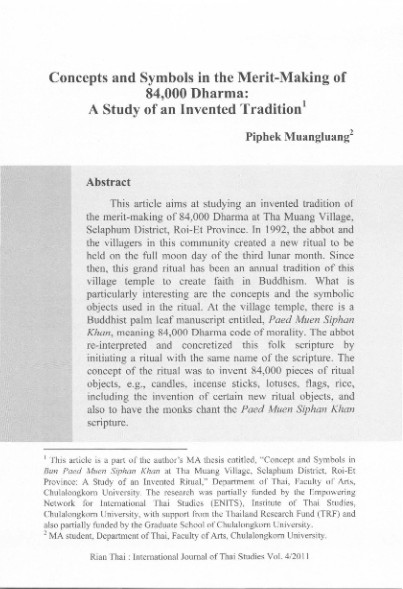Piphek Muangluang
Abstract
This article aims at studying an invented tradition of the merit-making of 84,000 Dharma at Tha Muang Village, Selaphum District, Roi-Et Province. In 1992, the abbot and the villagers in this community created a new ritual to be held on the full moon day of the third lunar month. Since then, this grand ritual has been an annual tradition of this village temple to create faith in Buddhism. What is particularly interesting are the concepts and the symbolic objects used in the ritual. At the village temple, there is a Buddhist palm leaf manuscript entitled, Paed Muen Siphan Khan, meaning 84,000 Dharma code of morality. The abbot re-interpreted and concretized this folk scripture by initiating a ritual with the same name of the scripture. The concept of the ritual was to invent 84,000 pieces of ritual objects, e.g., candles, incense sticks, lotuses, flags, rice, including the invention of certain new ritual objects, and also to have the monks chant the Paed Muen Siphan Khan scripture.
This article will identify the various concepts behind this merit-making, arguing that, in inventing this new tradition, the abbot combines Buddhist concepts with local beliefs. Moreover, this article will analyze the ritual symbols, including both the ritual objects and the ritual acts, and argue that the ritual symbols represent Buddhist Dharma, supernaturalism, fertility and Thai folk life. The merit-making of 84,000 Dharma indicates the role of Buddhism in Thai folk life, and helps to understand a kind of Thai Buddhism that is a syncretism between Buddhism, Brahmanism and the indigenous beliefs in supernaturalism.
(Published in Rian Thai: International Journal of Thai Studies, Volume 4/2011, Page 217-235)
Full Text : Download
